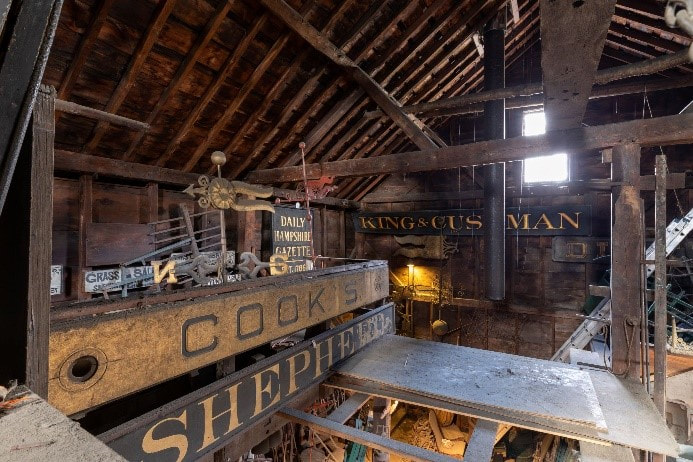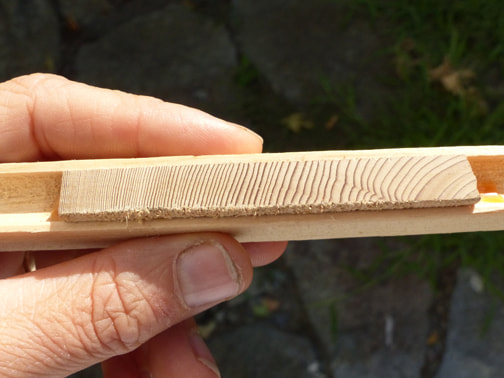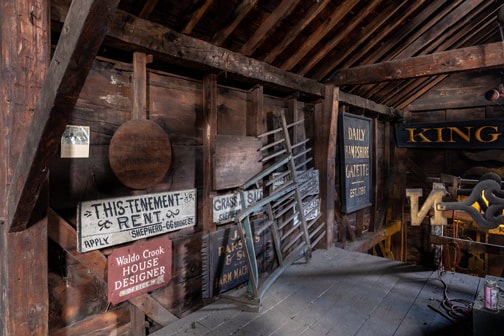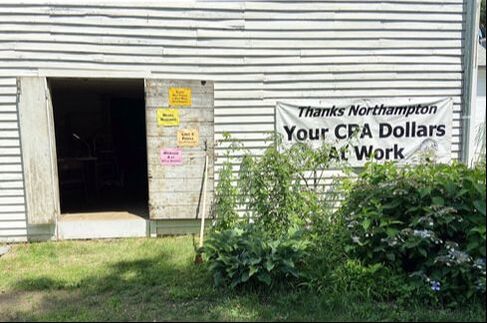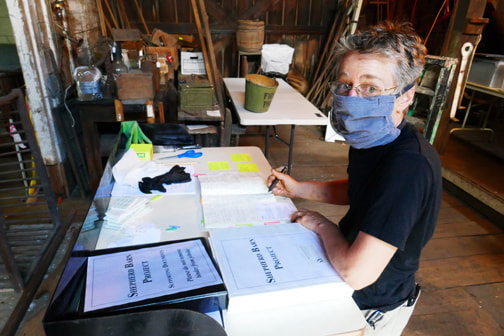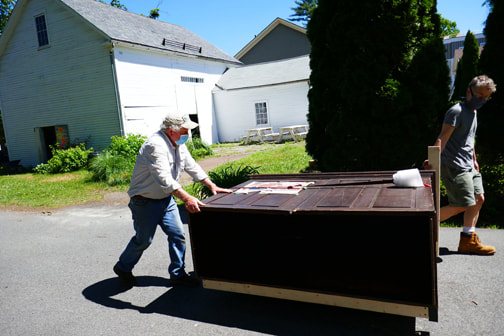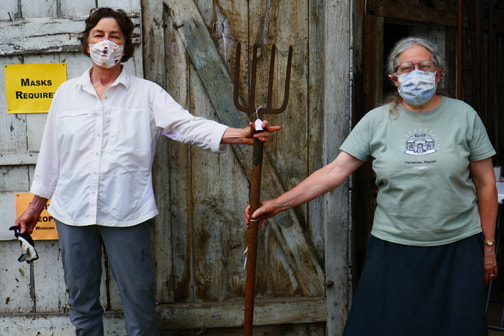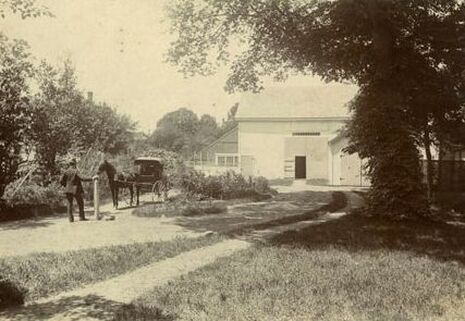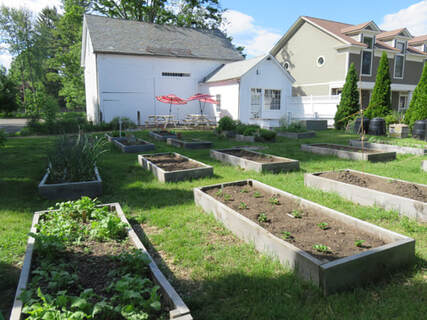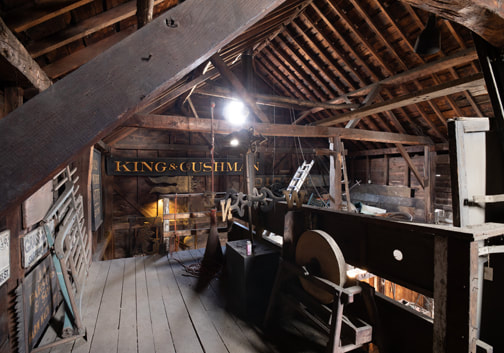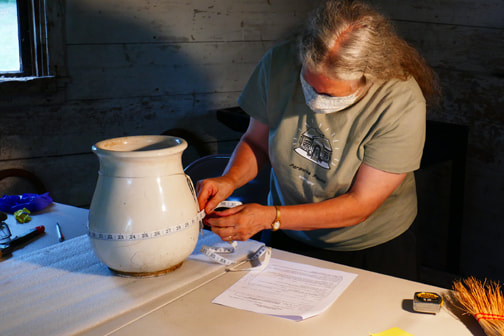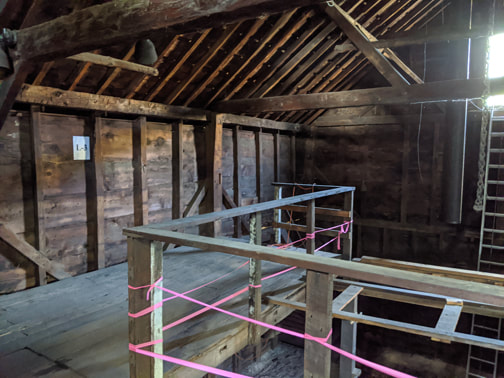Thank you for your online contribution
Your donation was successfully processed.
View of the loft of the Shepherd Barn.
Photograph by Paul Shoul, who photographed the barn
in March 2020 prior to the start of the project.
Photograph by Paul Shoul, who photographed the barn
in March 2020 prior to the start of the project.
Thanks to major funding from Northampton's Community Preservation Committee, Historic Northampton has begun a project to restore the Shepherd Barn. Before we can restore the barn, we must unravel the mysteries of its history.
- Master timber framer Jack Sobon spent a day investigating its physical characteristics.
- Staff and volunteers are researching the written record of the property’s owners.
- Contractor and fine-furniture maker Sharon Mehrman is leading the effort to remove the barn’s contents.
- Once the barn is empty, timber framer Alicia Spence will take up the floorboards and peel back some clapboards. With the barn’s frame exposed, Alicia and Jack will look for evidence of how it was built and clues to whether the building had been moved.
- An archaeologist will test the site beneath the barn.
The Barn Mystery: Preliminary Findings by Master Timber Framer Jack Sobon
|
Before any of the physical work began, we hired Jack Sobon, a master timber framer, author and architect, to write a detailed analysis of the structure's framing and carpentry.
During his career, Jack has drafted the plans for more than 300 timber-frame barns in our region and has become, in many ways, an architectural forensics detective. This past April, after spending a day in the barn, Jack discovered that the Shepherd “Barn” was not originally built as a barn or agricultural building. Sometime before 1850 it may have been moved here from elsewhere in town. His close inspection revealed:
|
Dovecote openings in the east gable of Shepherd barn provide evidence that an owner raised pigeons.
|
Since Jack’s discovery, we’ve been busy researching the property’s past ownership and use for clues about what the building might have been used for and by whom. Was it a craftsman’s space? Why was it divided? And when was it converted into a barn?
For the whole story, with drawings and photographs, read Jack Sobon’s preliminary report. If you know of a building as described in the report, please email Elizabeth Sharpe.
For the whole story, with drawings and photographs, read Jack Sobon’s preliminary report. If you know of a building as described in the report, please email Elizabeth Sharpe.
How Old is the Barn: Dendrochronology by Bill Flynt
|
Knowing the date the structure was built is the starting point for researching the barn's past ownership for more clues. For years, some suggested the barn dated to 1820 to 1840; others 1840 to 1860. In 2016, we hired Bill Flynt, Historic Deerfield’s architectural conservator, to use a technique called dendrochronology to date the timbers. He collected samples from twelve pitch pine timbers and one oak timber. Back in his lab, he polished the cores and compared the tree ring growth pattern (tree rings correspond to annual weather conditions) to a database. In this case, the growth patterns revealed that the twelve pitch pine timbers were cut between 1801 and 1802; the oak timber dated to 1804. Based upon this study, we are focusing our research on the occupations of the earliest Shepherd house owners, as well as accounts of buildings being moved in town, particularly around the time the canal was built and in use in the 1830s. We know that the barn was in its present location by 1853 when it can be seen on a town map. Read the entire dendrochronology study here. |
This polished core sample shows tree ring growth.
The dendrochronology study was funded by a Community Preservation Act grant. |
Removing the Contents of the Barn and Rehousing Artifacts
The barn holds an amazing collection of artifacts from farms, homes and public buildings, including: weathervanes, shop signs, toolboxes, a flax break, a scythe, a logging sled, sleighs, and bathtubs. Sharon Mehrman and volunteers are inventorying, cleaning, photographing and rehousing the artifacts. Sharon is a fine furniture maker and a 2019 graduate of the UMass/Amherst Public History Program. Last August, she was a Winterthur Fellow, researching 19th-century technology and woodworking.
Once the barn is empty, timber framer Alicia Spence will take up the floorboards and peel back some clapboards. With the barn's frame exposed, she and Jack Sobon, and other historic building specialists, will look for evidence of prior configuration, repairs and modifications indicating that the building had been moved.
Images (left to right): Sharon Mehrman inventorying in the barn. Sharon and Fred Morrison move the 19th-century cabinet with the town’s standard weights and measures to temporary storage. Barbara Blumenthal and Debin Bruce contemplate a pitchfork.
The Shepherd Barn and Property: 1896 and 2017
Susan Lorinda Brigham Munroe Shepherd (1821-1897) purchased the Shepherd property in her own name in 1856. Her husband Henry Shepherd (1811-1900) and son Thomas (1856-1923) were both horsemen, and the name of Thomas's horse, Br'er Fox, is still visible over the window to his stall.
The Shepherds had flower gardens and a drive between the house and the barn, and they bought the plot of land directly behind in (now the parking lot) to allow for more extensive vegetable gardening. Thomas's letters to his wife Edith in 1916 describe growing asparagus, tomatoes and fruit trees.
Today, the children of the Bridge Street School continue the gardening tradition on the Shepherd property. Through the Sprouts program, children are learning organic methods for growing vegetables.
The Shepherds had flower gardens and a drive between the house and the barn, and they bought the plot of land directly behind in (now the parking lot) to allow for more extensive vegetable gardening. Thomas's letters to his wife Edith in 1916 describe growing asparagus, tomatoes and fruit trees.
Today, the children of the Bridge Street School continue the gardening tradition on the Shepherd property. Through the Sprouts program, children are learning organic methods for growing vegetables.
